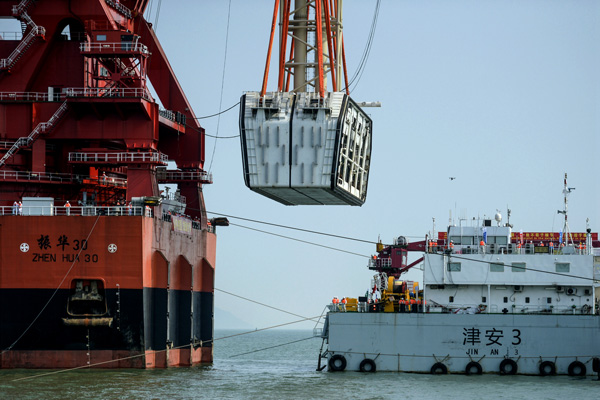Construction of the long-awaited Hong Kong-Zhuhai-Macao Bridge took a big step toward completion on May 2 when workers began to install the final piece of an underwater tunnel.
The final joint of the last 5.6-kilometer section was lowered into the Lingding Channel, the central channel of the Pearl River, in ideal weather conditions, according to Wang Zhanggui, chief engineer at the National Marine Environmental Forecasting Center.
Completion of the tunnel will effectively end work on the road link between Hong Kong, Macao and Zhuhai, Guangdong province. It is scheduled to open to traffic this year.
Once in operation, the bridge will shorten the current four-hour drive from Hong Kong to Zhuhai to just 30 minutes. Insiders estimate that the bridge will open to traffic on Dec 20, when Macao celebrates the 18th anniversary of its return to China from Portuguese control.
Lin Jiang, a professor at Sun Yat-sen University in Guangzhou, said the bridge will have great significance for economic cooperation and development in the greater Guangdong-Hong Kong-Macao bay area.

The Zhenhua 30 crane ship (left) hoists the final section of the underwater tunnel for the Hong Kong-Zhuhai-Macao bridge to its designated location on May 2.[Photo/China News Service]
“It is not only a bridge, but it will help accelerate the construction of networks of advanced expressways and intercity railways connecting the two special administrative regions with Pearl River Delta cities in Guangdong,” Lin said.
The bridge will also help Hong Kong shift its industries to vast areas in western Guangdong, he said.
Meanwhile, Macao and Hong Kong still have room for expansion and cooperation in tourism with the cities of western Guangdong province.
Zhongshan, the hometown of Sun Yat-sen, and Jiangmen, home to myriad overseas Chinese living around the world, are two major tourist destinations in Guangdong, he said.
“Furthermore, the operation of the bridge will encourage Guangdong to open wider to the outside world after the province further advances its cooperation with Hong Kong and Macao.”
The 55-kilometer Hong Kong-Zhuhai-Macao Bridge includes a 6.7-kilometer underwater tunnel and a 22.9 km bridge above the water’s surface, making it the longest cross-sea bridge in the world.
Construction of the Y-shaped bridge started in 2009 and will cost more than 10 billion yuan ($1.5 billion). It is part of the country’s planned national highway network linking the western and eastern banks of the Pearl River.
The service life of the bridge is expected to be more than 120 years.
